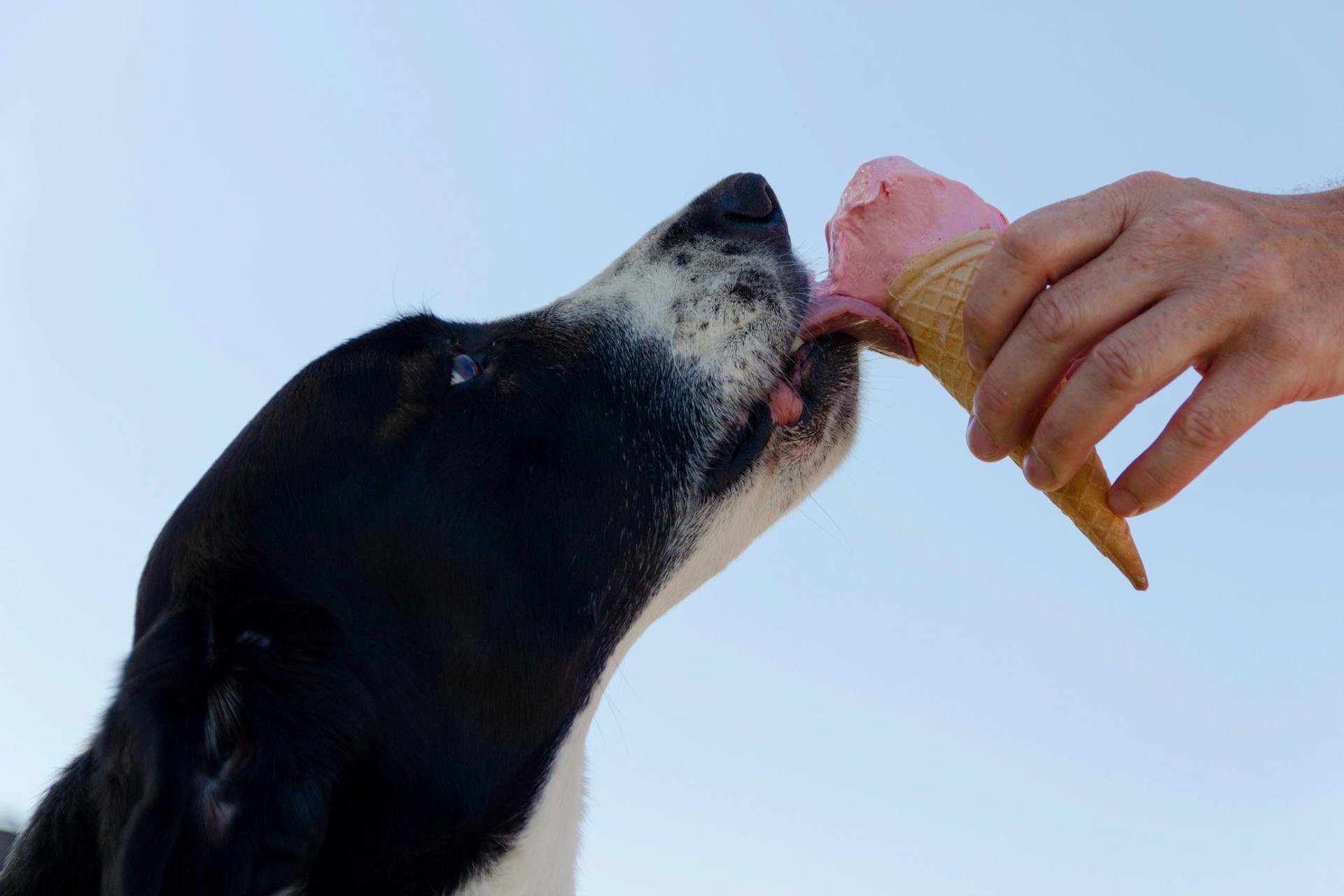
Pugs are prone to breathing problems due to their brachycephalic skull structure, which can cause their airways to become narrow and constricted.
Their short, flat face and long soft palate can obstruct airflow, leading to wheezing, snoring, and even life-threatening respiratory distress.
Pugs are also more likely to experience heatstroke and other heat-related illnesses due to their compact body type and brachycephalic features.
Regular exercise and playtime can help strengthen their respiratory system, but it's essential to avoid overexertion and provide plenty of rest and hydration to prevent heat-related issues.
Recommended read: Dog Upper Respiratory Infection vs Kennel Cough
Causes and Diagnosis
Pug dogs are prone to breathing problems due to their flat faces and short snouts, which can cause their airways to become narrow and obstructed. This is known as brachycephalic airway syndrome.
The causes of breathing difficulties in pugs are varied and can include foreign objects stuck in the throat, elongated soft palate, small nostrils, and even heart failure. It's not uncommon for pugs to experience breathing difficulties, especially during exercise or in hot weather.
One of the most common signs of breathing difficulties in pugs is rapid breathing, also known as tachypnea. This can be caused by conditions such as anemia, asthma, or bleeding into the lungs.
Some possible causes of breathing difficulties in pugs include:
- Foreign object stuck in throat
- Elongated soft palate
- Small nostrils
- Ascites, or fluid in the belly
- Bloat, or air in the belly
- Enlarged liver
- Bacterial or viral infection
- Tumors
- Allergies
- Asthma
- Injury to chest wall
- Reaction to toxin from tick bite
- Reaction to toxin from Botulism
- Heart failure
- Pulmonary edema, or heart failure with fluid in the lungs
- Blood in the chest surrounding lungs
- Bleeding into the lungs
- Pneumonia
- Infectious tracheobronchitis, or a kennel cough
- Heartworm infection
Diagnosing breathing difficulties in pugs requires a thorough physical examination, including observation of the dog's breathing and listening to her chest and lungs. Your veterinarian may also recommend additional tests, such as x-rays, ultrasounds, or blood work, to determine the underlying cause of the breathing difficulties.
Symptoms and Signs
Pugs are adorable, but their breathing problems can be a real concern. Pugs are brachycephalic, meaning they have a short, flat face, which can cause them to have breathing difficulties.
Noisy breathing is a common symptom of brachycephalic airway syndrome. This can be especially noticeable during exercise or excitement.
Dogs with brachycephalic airway syndrome often breathe more easily through their mouths than their noses. This is because their airways are narrowed or obstructed.
Check this out: Blue Doberman Syndrome
Pugs may snore when relaxed or asleep, which is a normal sign of brachycephalic airway syndrome. However, if your pug is snoring loudly or frequently, it's worth discussing with your veterinarian.
Some pugs may tire easily with exercise, which can be a sign of brachycephalic airway syndrome. This is because they have to work harder to breathe.
Pugs with brachycephalic airway syndrome may also exhibit other signs, such as coughing, gagging, retching, and vomiting. These symptoms can be especially problematic in hot or humid weather.
In severe cases, pugs with brachycephalic airway syndrome may collapse or faint after exercise. This is a serious sign that requires immediate veterinary attention.
Here are some common signs of brachycephalic airway syndrome in pugs:
- Noisy breathing
- Snoring
- Gagging or retching
- Coughing
- Trouble breathing or increased effort to breathe
- Increased panting
- Exercise intolerance (tire easily with exercise)
- Distended abdomen or vomiting from swallowing too much air while working to breathe
- Overheating
- Pale or blue gums
- Collapse
Treatment and Management
Medical management is an option if your pug's breathing problems are mild or infrequent. Excessive weight worsens the symptoms, so weight loss is crucial if your pug is overweight or obese. Heat and humidity can also worsen clinical signs, so care should be taken to limit time outside during hot summer days.
Curious to learn more? Check out: Why Do Yorkshire Terriers Lick so Much
Exercise can increase stress of breathing and may exacerbate pug dog breathing problems. If your pug is having trouble breathing while at the vet, they may utilize mild sedatives to help your pug calm down and breathe easier.
Surgery may be considered if the structural abnormalities cause distress to your pug, become worse over time, or result in life-threatening trouble breathing from upper airway blockage. Life-threatening would be defined as more than one episode where your pug has had trouble breathing and needed medical assistance.
Multiple procedures are usually required to alleviate the signs of pug dog breathing problems, and include:
- Stenotic nares resection: Surgically widening the nostrils.
- Soft palate resection (staphylectomy): Surgical trimming of the soft palate to shorten the tissue.
- Laryngeal saccule removal: Removing the everted saccules.
All three procedures can be performed at the same time, and this is typically most recommended. Most pugs with breathing problems are diagnosed by 4 years old, but surgical correction can be performed as early as 4 months of age. Early diagnosis and surgical intervention may help reduce complications of chronic upper airway disease, such as developing laryngeal collapse.
Dogs undergoing brachycephalic airway surgery are monitored carefully after surgery, as inflammation and bleeding are possible. Typically, they will remain hospitalized in a 24-hour ICU for 1-2 days of observation. The prognosis is good for young dogs, and most pet parents see a significant improvement in their breathing and ability to exercise.
Check this out: Early Signs of Ivdd in Dachshunds
Surgery and Costs
The cost of surgery for brachycephalic airway syndrome can vary depending on many factors, including geographic location, how sick the dog is, and how extensive the procedure needs to be.
Pet parents can likely expect to pay a total between $3,000 and $5,000 if all three procedures are performed.
Pet insurance may be a good idea to help offset anticipated costs and illnesses related to getting a new pup.
Surgery Success Rate
The success rate of surgery for pets with certain syndromes depends on the timing of the procedure. The earlier the abnormalities are corrected, the better the outcome.
In fact, the condition can worsen over time and may cause other abnormalities if left untreated. Early correction of stenotic nares and/or an elongated soft palate can significantly improve airway function.
Swelling of the surgical sites after surgery is a common occurrence and can interfere with breathing. Your veterinarian will closely monitor your pet after the surgery to ensure a smooth recovery.
Surgery Cost
Surgery for brachycephalic airway syndrome can be expensive, with a total cost ranging from $3,000 to $5,000 if all three procedures are performed.
The cost depends on various factors, including geographic location and the dog's level of sickness.
Pet insurance may be a good idea to help offset these costs, but not all policies cover inherited and breed-related conditions like brachycephalic airway syndrome.
Make sure to consider a policy that covers brachycephalic dogs and their specific health issues.
Curious to learn more? Check out: Canine Diabetes Treatment Cost
Pug Dog Breathing Problems
Pug dogs are prone to breathing problems due to their brachycephalic airway syndrome, which is caused by their shortened snout and flat face.
This condition can lead to a range of breathing difficulties, including stenotic nares, which means their nostrils are narrowed or small, restricting airflow. The elongated soft palate, which is the soft part of the roof of the mouth, can also block the entrance to the trachea, making it harder for pugs to breathe.
Broaden your view: English Bulldog Soft Palate Surgery
Pugs with brachycephalic airway syndrome may also experience everted laryngeal saccules, which means the small sacs in the back of the throat are turned inside out, further blocking the airway.
Here are some common symptoms of brachycephalic airway syndrome in pugs:
- Stenotic nares (narrowed or small nostrils)
- Elongated soft palate (soft palate is too long for the length of the mouth)
- Everted laryngeal saccules (small sacs in the back of the throat are turned inside out)
- Labored breathing or panting
- Overheating due to restricted airflow
Dog Breeds Considered
If you're considering bringing a new furry friend into your family, it's essential to know that some dog breeds are more prone to breathing problems than others.
The breeds considered brachycephalic, or having a short, flat face, can experience difficulties breathing due to their physical characteristics.
This group includes the Affenpinscher, Boston Terrier, Boxer, Bullmastiff, Brussels Griffon, Cane Corso, Chow Chow, Dogue de Bordeaux, English Bulldog, English Toy Spaniel, French Bulldog, Japanese Chin, Lhasa Apso, Pekingese, Pug, and Shih Tzu.
Each of these breeds has unique needs and requirements to ensure they stay healthy and happy.
The English Bulldog, for instance, can experience respiratory distress due to its brachycephalic features, which may require special care and attention from their owners.
Broaden your view: Good Breeds for Psychiatric Service Dogs
Some breeds, like the Pug, may require more frequent breaks during exercise to prevent overheating and breathing difficulties.
The list of brachycephalic breeds is quite extensive, and it's crucial to research and understand the specific needs of each breed before making a decision.
Here is a list of the breeds mentioned earlier:
- Affenpinscher
- Boston Terrier
- Boxer
- Bullmastiff
- Brussels Griffon
- Cane Corso
- Chow Chow
- Dogue de Bordeaux
- English Bulldog
- English Toy Spaniel
- French Bulldog
- Japanese Chin
- Lhasa Apso
- Pekingese
- Pug
- Shih Tzu
Guide to Problems
Pug Dog Breathing Problems can be a real concern for owners. Brachycephalic airway syndrome is a condition that affects short-nosed breeds, like Pugs, causing breathing problems.
The condition is made worse by exercise, heat, and obesity. In Pugs, the narrow nostrils and elongated soft palate cause breathing problems that get progressively more severe as the dog gets older.
Pugs suffer from stenotic nares, which means their nostrils are malformed or restricted, collapsing inwards when they breathe in. This is due to the shortened muzzle and relatively flat-faced head structure.
The elongated soft palate is another issue, as it protrudes into the airway, interfering with the movement of air into the lungs. This, combined with nasal stenosis, increases the negative pressure during breathing, leading to chronic inflammation and swelling in the upper respiratory tract.
Here are the specific airway-related conditions that can occur in Pugs with brachycephalic airway syndrome:
• Stenotic nares: Narrow nostrils or small nostril openings, restricting airflow and increasing panting and overheating risk.
• Elongated soft palate: The soft palate is too long for the length of the mouth, causing snoring and blocking airflow into the windpipe and lungs.
• Everted laryngeal saccules: The saccules turn inside out due to increased breathing effort, further blocking the airway.
Other potential problems that can occur due to brachycephalic airway syndrome in Pugs include:
• Bronchial collapse: Weakening and collapse of the bronchi, causing further obstruction.
• Gastroesophageal reflux: Intestinal fluids flow back into the esophagus, causing discomfort and potential health issues.
Recommended read: Tracheal Collapse in Cats
Sources
- https://vcahospitals.com/know-your-pet/brachycephalic-airway-syndrome-in-dogs
- https://sydneyanimalhospitals.com.au/dog-breathing-problems-brachycephalic/
- https://www.dogster.com/ask-the-vet/brachycephalic-flat-faced-dog-health-problems
- https://wagwalking.com/condition/breathing-difficulties
- https://www.petmd.com/dog/conditions/respiratory/brachycephalic-airway-syndrome-dogs
Featured Images: pexels.com


